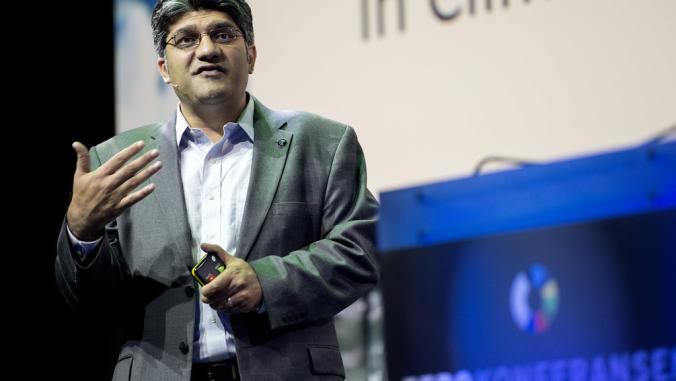Mainspring Energy was founded in 2010 by a trio of Stanford Ph.D.s, born not out of the university’s legendary coding schools but rather from its thermodynamics lab. Back at a time when the startup world was growing wary of cleantech, the team targeted a tough task: to drive down emissions by reinventing one of the grid’s most fundamental technologies.
Their target? The nearly 200-year-old design of the electric generator. Where practically all mechanical generators spin in a circle, relying on rotating magnets to generate current, Mainspring engineered a design that moves back and forth in a line.
It's a simple physical reorientation with potentially dramatic impact. The resulting "linear generator" delivers efficiencies that co-founder and chief executive Shannon Miller says produce electricity more cleanly, at a lower cost and more flexibly than can a multi-billion-dollar market of incumbents, including turbines, reciprocating engines and fuel cells.
And after a decade of development, the linear generator is scaling into commercial production at a time of sharply growing demand for flexible options that can support the grid sustainably. "Extreme weather events and the rise of electrification are driving increasing demands on the electric grid for affordable resiliency," Miller said. "At the same time, we need to be moving rapidly toward a net-zero-carbon grid."
A utility milestone
Following a handful of corporate and institutional deployments beginning in 2020, Mainspring’s first utility project was announced this week in Angwin, California.
The town is a crucial node on Pacific Gas & Electric’s network in Napa County, a microgrid distribution point where a generator is positioned to stabilize the daily ebbs and flows of power, as well as to supply downstream customers if transmission into the area goes down. And during California's epic drought and record wildfire season, that’s been happening more often, as PG&E resorts to public safety power shutoff (PSPS) events to avoid sparking new fires.
Occupying a footprint about the size of a parking space, the 240-kilowatt linear generator will initially run in tandem with a conventional diesel reciprocating engine, while PG&E commissions the unit. Multiple Mainspring units can be paired to increase output. In time, Miller expects the linear generator to take over fully, as it does things the diesel cannot.
The tailwinds for us keep getting stronger.
For example, thanks to precise power electronics, the Mainspring unit can ramp up and down almost instantaneously, to better match microsecond grid fluctuations. And as renewables multiply, power supplies are growing more variable and less stable overall, so increased responsiveness is good for the grid.
And its low emissions should be good for nearby communities. As utilities have increased their reliance on portable diesel generators to stabilize the grid, rising air pollution is hitting nearby populations, often in disadvantaged communities.
Compared with the nearby diesel engine, Mainspring’s generator cuts nitrogen oxide (NOx) emissions by more than 90 percent and lowers particulate pollutants proportionately. Fueled by biogas, it emits virtually no carbon. And in the future, the unit can run on practically any gaseous fuel, Miller said, including emerging zero-carbon fuels such as renewable propane or green hydrogen.

The Mainspring linear generator core.
How it works
Mainspring’s performance edge arises from the architecture of its design, combined with the benefits of its state-of-the-art power electronics, an area of technology that, thanks to the scaling of renewables, has advanced rapidly during Mainspring’s decade of development. "Those systems allow us to do all the control, to achieve fuel flexibility, dispatchability and efficiency," Miller said.
Physically, the design reorients familiar elements of an electric generator — magnets moving through loops of copper wire. Rather than spinning in circular motion like most generators, in Mainspring’s design, the magnets slide to and fro along a horizontal axis with precision that varies by less than the width of a piece of paper.
When a mix of fuel and air enters the central reaction zone, it is not combusted. Rather, via a low-temperature reaction, pressure directly converts thermochemical energy into motion which pushes two pistons — Mainspring calls them oscillators — outward from the center.
Power is produced as magnets mounted on the oscillators pass through copper coils embedded in the shell.
When the oscillators reach the limit of their travel, they compress air at the far end of the cylinder, creating a spring-like pressure that rebounds them back toward the center, generating more power on the return journey.
With only two moving parts, Mainspring’s design can generate more power per unit of fuel than other mechanical generators. Miller said. At the same time, its simplicity incurs lower maintenance and material costs. Unlike turbines or engines, its innovative air bearing system needs no oil or routine parts replacement. And unlike fuel cells, no costly catalysts need be replaced.
By operating at relatively low heat, the design virtually eliminates NOx emissions and other harmful byproducts of combustion. Taken together, the design advances "can deliver the high efficiency and low emissions of fuel cells with the low cost and dispatchability of engines and microturbines," Miller said.

The Mainspring generator at an installation site (this is not the PG&E implementation).
Financing growth
This bundle of advantages has attracted a wave of blue chip investors. In May, Mainspring capped a Series D round of $95 million, led by Fine Structure Ventures (previously Devonshire Investors), the private equity firm affiliated with Fidelity Investments’ parent company FMR, along with support from 40 North Ventures, Chevron Technology Ventures and Princeville Capital.
The D round brings to $228 million the total raised by the startup to date, building on earlier commitments from Khosla Ventures in Round A and Bill Gates in Round B. The Series C included a mix of strategic energy industry partners: AEP, Centrica, ClearSky Power & Technology and Equinor.
In March, Mainspring announced a partnership with U.S. utility and renewables giant NextEra Energy — the world’s largest private-sector generator of renewable energy.
Via its business services arm NextEra Energy Resources, the deal commits $150 million to help Mainspring’s customers buy, finance and deploy the new generators, principally via arrangements like power purchase agreements (PPAs), where customers need not buy the asset outright and can instead pay recurring fees.
We're not spending capital on this. That's for other companies to do. We're not maintaining it. That's for other companies to do.
NextEra also offers the startup a strong partner with which to scale up green hydrogen. In July 2020, NextEra announced a pilot green hydrogen project with Florida Power & Light. For Mainspring, NextEra’s expertise in deploying emerging renewables into the grid offers a leg up and a fast track to partner with new clients. "Our strategy is find partners that understand where the grid is going and can really help us scale," said Miller.
Mainspring’s two publicly disclosed customers, PG&E and Kroger, both opted for PPA-style financing via NextEra. For Kroger, the deal offered a way to improve the reliability of energy supply at one of its Los Angeles-area stores, while cutting costs and lowering emissions — all with minimal upfront commitment.
"We're not spending capital on this. That's for other companies to do. We're not maintaining it. That's for other companies to do," said Denis George, energy manager at The Kroger Co. "That puts us on a very equivalent basis to buying power from the utility."
The grocer is facing an increasingly common bind: the squeeze of rising costs for grid-supplied electricity along with pressure to cut emissions from onsite power sources.
"We’ve already done practically everything we can on efficiency," George said. The linear generator helps Kroger improve sustainability by moving towards its enterprise-wide goal of cutting greenhouse gas emissions by 30 percent.
Reliability vs. climate
Kroger’s priorities mirror those of a growing number of big energy users for whom decarbonization goals are running up against the challenges of climate change and grid instability.
Along with California, much of the west is in a similar predicament, as rising temperatures are driving electricity demand, just as drought is diminishing hydropower output and fire is threatening major transmission lines.
The pressure is pushing governments, utilities and companies alike to boost spending on backup power, even when it may not meet green goals. In July, despite supporting some of the nation’s most ambitious decarbonization targets, California’s governor declared an emergency, a move that permitted rapid deployment of fossil-fueled backup solutions and sped the rollout of new clean energy projects.
The following month, the state energy commission OK'd five temporary gas-fired generators to reduce blackout risks. As GreenBiz’s Sarah Golden noted in her weekly newsletter, "[California] officials are faced with the difficult choice of alleviating suffering today or curbing catastrophe tomorrow."
Mainspring offers a way to meet both priorities. Near term, it can responsively generate low-emissions, affordable energy. And into the future, its fuel flexibility enables it to handle tomorrow's clean fuels, Miller said. Compared with a decade ago, "The tailwinds for us keep getting stronger."






